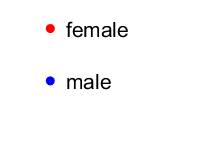Predictions & Data for this entry
| Model: std | climate: Cfa | migrate: TT | phylum: |
| COMPLETE = 2.5 | ecozone: THn | food: biCi | class: |
| MRE = 0.035 | habitat: 0jFc, jiTf | gender: Dg | order: |
| SMSE = 0.002 | embryo: Tns | reprod: O | family: |
Zero-variate data
| Data | Observed | Predicted | (RE) | Unit | Description | Reference |
|---|---|---|---|---|---|---|
| ab | 15 | 15.88 | (0.05854) | d | age at birth | amphibiaweb |
| tp | 1825 | 1788 | (0.02027) | d | time since birth at puberty for females | Marv2017 |
| tpm | 1460 | 1528 | (0.04654) | d | time since birth at puberty for males | Marv2017 |
| am | 5840 | 5840 | (7.376e-05) | d | life span | Marv2017 |
| Lp | 4.7 | 4.979 | (0.05945) | cm | SVL at puberty | Marv2017 |
| Lpm | 5.2 | 4.655 | (0.1049) | cm | SVL at puberty for males | Marv2017 |
| Li | 6.3 | 6.113 | (0.02964) | cm | ultimate SVL | Marv2017 |
| Lim | 5.8 | 6.073 | (0.04708) | cm | ultimate SVL | Marv2017 |
| Wwb | 0.00141 | 0.001385 | (0.01778) | g | wet weight at birth | Wiki |
| Wwi | 1.94 | 1.942 | (0.001076) | g | ultimate wet weight | guess |
| Ri | 0.03288 | 0.03287 | (0.0002855) | #/d | maximum reprod rate | amphibiaweb |
Uni- and bivariate data
| Data | Figure | Independent variable | Dependent variable | (RE) | Reference |
|---|---|---|---|---|---|
| tL_f |   | time since birth | SVL | (0.03271) | Marv2017 |
| tL_m |   | time since birth | SVL | (0.03849) | Marv2017 |
Pseudo-data at Tref = 20°C
| Data | Generalised animal | Plethodon kentucki | Unit | Description |
|---|---|---|---|---|
| v | 0.02 | 0.05472 | cm/d | energy conductance |
| p_M | 18 | 34.57 | J/d.cm^3 | vol-spec som maint |
| k_J | 0.002 | 0.002 | 1/d | maturity maint rate coefficient |
| k | 0.3 | 0.4226 | - | maintenance ratio |
| kap | 0.8 | 0.9843 | - | allocation fraction to soma |
| kap_G | 0.8 | 0.8018 | - | growth efficiency |
| kap_R | 0.95 | 0.95 | - | reproduction efficiency |
Discussion
- Males are assumed to differ from females by {p_Am} and E_Hm only
- Temperatures are guessed
- mod_1: males have equal state variables at b, compared to females
Facts
- Males slightly smaller than females (Ref: Marv2017)
- The larval stage is passed within the egg capsule; reproduction is terrestrial (Ref: amphibiaweb)
Acknowledgment
- Eric Liebgold kindly helped collecting data for this entry
Bibliography